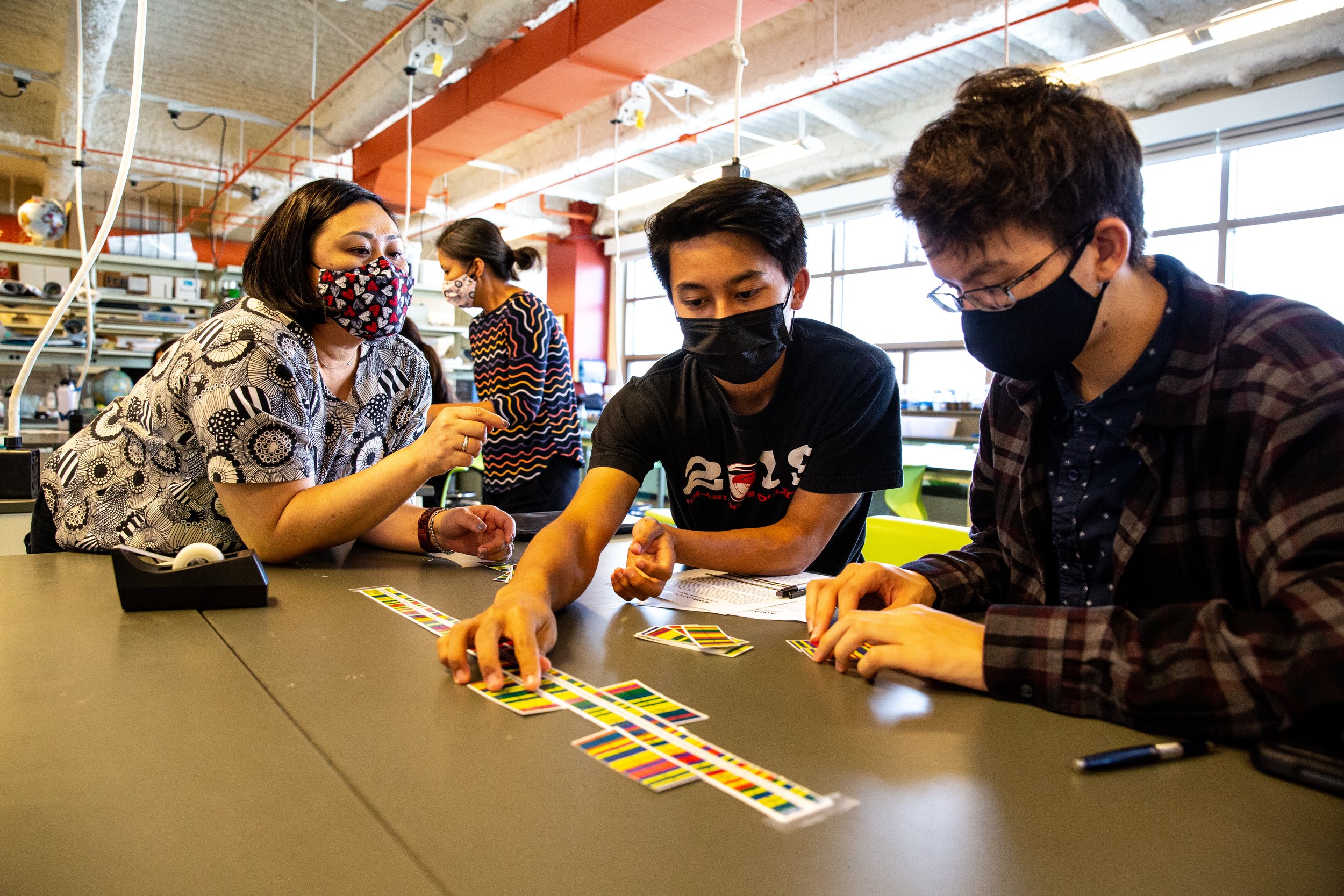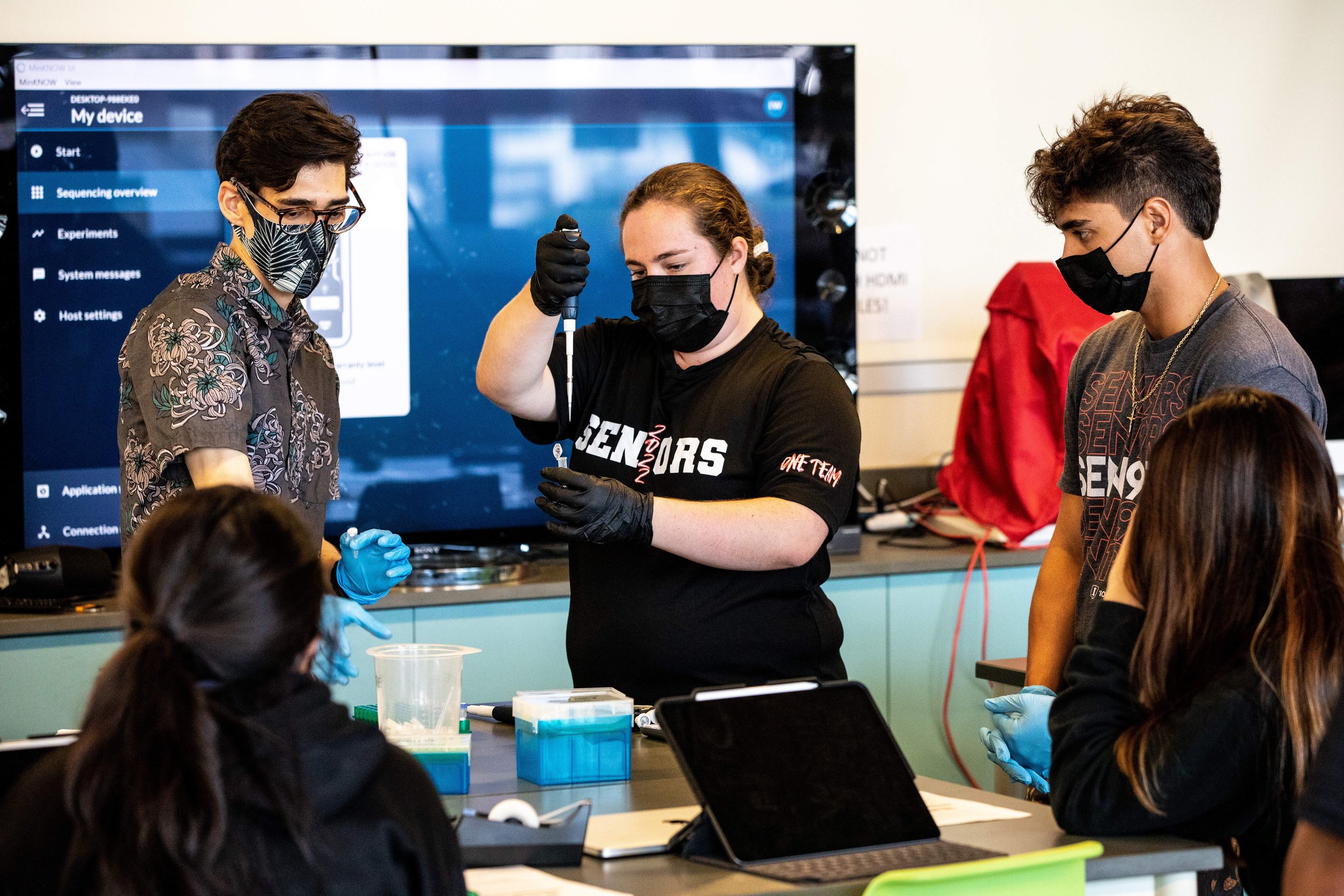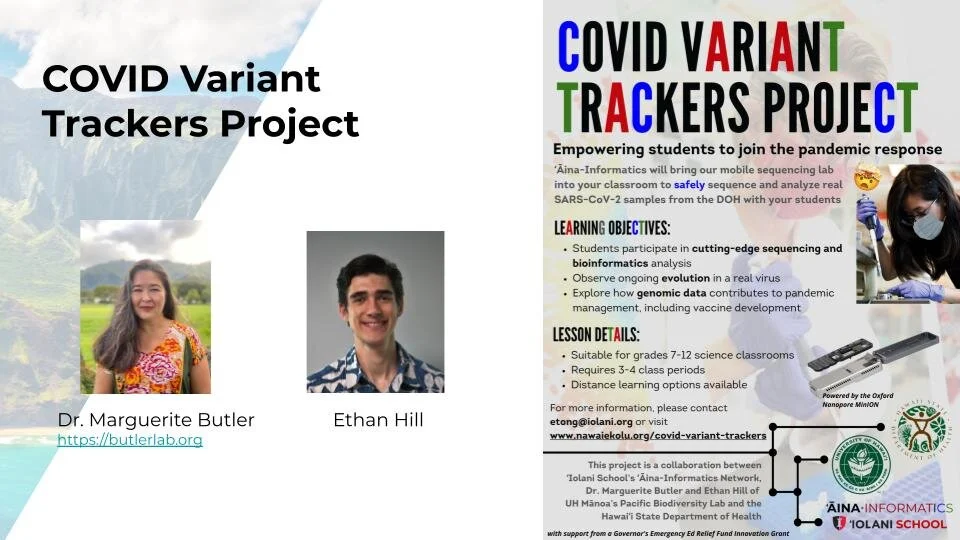In Spring 2021, ʻĀina-Informatics partnered with Dr. Ed Desmond (Hawaiʻi Department of Health) and Dr. Marguerite Butler (University of Hawaiʻi at Mānoa, Pacific Biodiversity Lab) to design the COVID Trackers Project, a lab-based curriculum which enabled students to use MinION sequencing technology to contribute towards variant assignment of SARS-CoV-2 samples. All test samples were isolated from individuals who tested positive at State testing locations between 4/22/2021 and 8/31/2021 (capturing the Delta surge in Hawaiʻi) and only brought into classrooms once processed and deactivated by our DOH and UHM collaborators.
Dr. Marguerite Butler (University of Hawaiʻi at Mānoa - College of Natural Sciences)
Dr. Ed Desmond (Hawaiʻi Department of Health - Public Health and Environmental Laboratories)
The in-classroom activities were enabled by the use of a custom mobile sequencing lab outfitted with all the necessary equipment and reagents to conduct this outreach. Lab curricula were designed around the ARTIC Network workflow for processing and sequencing SARS-CoV-2 using a tiled amplicon approach. Beginning with amplicons generated by the Butler Lab, students first constructed multiplex sequencing libraries pooling 6 genomes at a time with NEB’s ARTIC SARS-CoV-2 Companion Kit for Oxford Nanopore Technologies. During the course of this project, our collaborators in the Butler Lab utilized multiple primer schemes (including VarSkip and VarSkip v2) for amplicon generation as each scheme became available. The majority of the sequencing runs were performed on MinION Flongle flow cells, with a smaller subset completed using standard MinION flow cells. Reads were analyzed in real time in the classroom using RAMPART, with final assembly and variant confirmation conducted in Medaka and Pangolin outside of the classroom. A portion of these consensus sequences were contributed to GISAID in Spring 2022. Finally, students ran a biogeographical analysis of 212 publicly available SARS-CoV-2 genomes relevant to Hawaiʻi using data and R scripts developed by Ethan Hill (Butler Lab) and powered by RStudio Cloud.
Ethan Hill (Butler Lab, UH Mānoa) coaching a ʻIolani School student in COVID sequencing library preparation.
Photo credits: Eric Wehner
Global Health teacher Nan Ketpura-Ching working with students on a COVID-19 genome assembly puzzle.
An excerpt from a biogeographic reconstruction generated by students in RStudio Cloud depicting chains of transmission of COVID into and through our islands.
This project has been generously supported in part by a Governor’s Emergency Educational Relief Grant as well as a sponsorship from Hawaiʻi Dental Service.
Schools and student reach
The COVID Trackers Lab was conducted at 14 participating schools on three islands during SY2021-22, reaching over 640 local students. Of these, 2 were public middle schools, 8 were public high schools, 2 were public charter schools and 2 were private schools.
| School | Island | Genomes Attempted |
Participating Teachers |
Student Reach |
|---|---|---|---|---|
| ʻIolani School | Oʻahu | 114 | 2 | 24 |
| ʻAiea High School | Oʻahu | 12 | 1 | 17 |
| Waipahu High School | Oʻahu | 12 | 1 | 28 |
| King Intermediate School | Oʻahu | 24 | 2 | 83 |
| Kailua Intermediate School | Oʻahu | 30 | 1 | 90 |
| Kahuku High School | Oʻahu | 60 | 2 | 208 |
| Hawaiʻi Baptist Academy | Oʻahu | 96 | 2 | 15 |
| Kailua High School | Oʻahu | 12 | 1 | 22 |
| Hawaiʻi Technology Academy Kona | Hawaiʻi | 6 | 1 | 8 |
| Kapaʻa High School | Kauaʻi | 18 | 2 | 28 |
| Hawaiʻi Technology Academy Kauaʻi | Kauaʻi | 6 | 1 | 19 |
| Kauaʻi High School | Kauaʻi | 6 | 1 | 20 |
| Radford High School | Oʻahu | 12 | 1 | 46 |
| Hilo High School | Hawaiʻi | 12 | 1 | 35 |
| TOTALS | 420 | 19 | 643 | |
A student at King Intermediate School preparing a sequencing library for loading on a MinION Flongle flow cell.
Photo credit: E. Tong
Data
The student generated data include a total of 236 unique samples sequenced in classrooms 6 or 12 at a time plus two additional 96-well plates. A subset of the 236 unique samples (n = 84) were resequenced in classrooms when prior sequencing runs in the Butler Lab yielded insufficient reads, allowing for multiple datasets to be merged for a more robust combined sequencing depth.
A summary of student-generated variant assignments by sampling week (96 well plate samples omitted).
The vast majority of samples sequenced were taken from surge testing efforts on or around 8/12/2021, with results capturing the Delta surge across the islands. Approximately 70% of all samples originated on Oʻahu, 20% in Hawaiʻi County, and 5% each in Kauaʻi and Maui counties.
Reflections
The disruption to school and student learning brought upon by the COVID pandemic may not yet be fully understood, but the pandemic forced all of us to think outside the box and innovate new ways to engage students both in and out of the classroom. At the same time, the DOH was facing a shortage of skilled technicians crucial in developing the sequencing infrastructure required to conduct genomic surveillance of a new virus. This unique confluence of problems was met head on with a bold idea: to train the next generation of genome scientists in the midst of an ongoing genome science crisis.
With huge mahalo for our academic and funding partners, the ʻĀina-Informatics Network rallied around this bold idea, committing countless hours and resources in order to empower students to join the pandemic response. In a year where COVID held control over their everyday lives, students found a way to assert agency over COVID using a pipette, a sequencer and a laptop.
Kailua High School students presenting a completed COVID genome assembly puzzle designed to illustrate the evolution of new variants.
Photo credit: Sara Anglin
The pandemic also opened up new case studies in bioethics, especially surrounding the novel mRNA vaccines developed with unthinkable speed in response to variant after variant. Ripped straight from the headlines, our bioethics unit engaged students in considering the ethics surrounding the initially limited vaccine rollout, subsequent mandating of vaccines in the workplace and the inequities in the global distribution of vaccine access.
We are grateful for the opportunity to have brought this project to so many in our community of schools, but we are also relieved that the pandemic is at a place where genomic surveillance at this scale is no longer necessary. And while the pandemic brought with it heartache and suffering, it has also presented a unique opportunity for our program to directly engage students in genome science in the most timely and urgent way possible. It is our hope that among the students we reached with this project is a new generation of homegrown genome science professionals ready to lead us through the next crisis when it arrives.
Media coverage
September 8, 2021 - Bytemarks Cafe on Hawaiʻi Public Radio

















